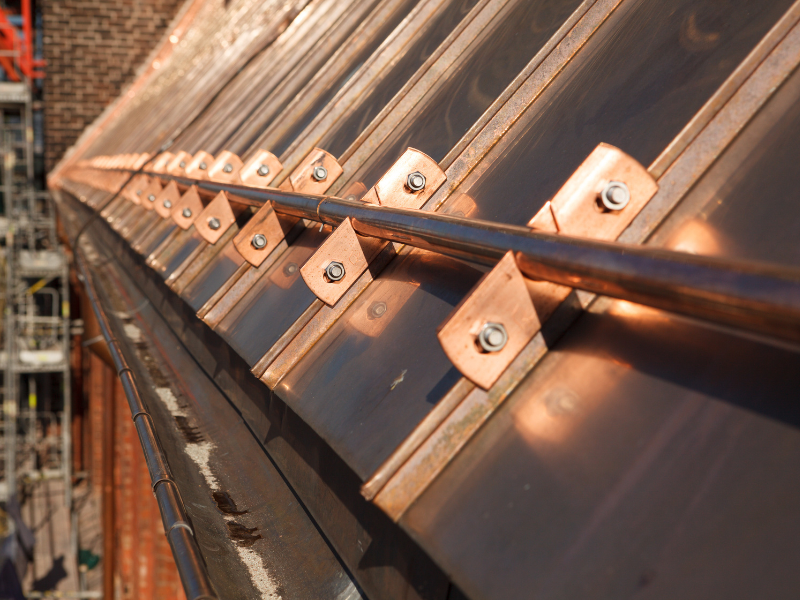With the ongoing climate crisis affecting the globe, there’s an urgent call for sustainable building materials in the construction industry, in order to shape a sustainable future for everyone.
Copper has long been used in construction projects, but in recent years has faced increasing competition from plastic – a shift which has had a significant impact on the environment.
The industry is in desperate need of limiting its considerable environmental impact, with copper perfectly placed to support the transition to more sustainable construction practices.
What is sustainable construction?
Sustainable construction refers to the use of recyclable and renewable building materials in projects, minimising both energy consumption and waste production as much as possible.
The key goal of sustainable construction is to reduce the pressure put on the environment, a mission which has become all the more important amid the rising use of plastic in construction.
Sustainable construction continues after the completion of a building project too, with the design of the building itself needing to have a minimal impact on the environment over its lifespan.
This includes using materials that can influence the structure’s environmental impact. Examples of this could be solar panels, appropriate insulation to prevent heat loss and long-lifespan building materials being used during renovation or retrofitting.
Why is sustainable construction important?
Government data shows that construction, demolition and excavation projects generate 62% of all waste in the UK. As one of the major contributors to climate change, the construction industry has a duty to turn the tide and embrace more sustainable practices.
Green construction is beneficial and crucial for the long-term environmental, economic and social prosperity of communities. Environmentally, prioritising eco-friendly materials and practices in sustainable construction helps preserve ecosystems, conserve natural resources and reduce energy consumption.
In turn, this leads to a decrease in greenhouse gas emissions and a lower carbon footprint, as well as improved water management, waste reduction and promoting biodiversity.
On the financial impact, employing sustainable practices and materials can significantly reduce long-term operational costs in areas such as energy, water and maintenance.
In addition, making buildings sustainable will increase their market value, with more money expected to be generated as the demand for eco-friendly properties continues to surge.


The social benefits of sustainable construction are just as important, helping to improve the well-being and quality of life among a specific community.
Sustainable buildings are now designed with features to promote healthier indoor environments, with access to green spaces, better air quality and increased natural light at the forefront of these projects. These added touches can improve the physical and mental well-being of residents, leading to increased satisfaction.
Businesses can also add social value, placing an emphasis on locally sourced materials and labour, strengthening regional economies and increasing job opportunities.
Sustainable construction practices can be used to support wider company goals associated with corporate social responsibility, allowing developers to showcase their commitment to sustainability in the industry and to the public.
Copper’s role in sustainable construction
Copper has an important part to play in the future of the construction industry, with its versatile and recyclable properties providing numerous benefits over plastic.
Despite just 9% of plastic ever produced being recycled, the material has become a mainstay of most new-builds due to its low cost – and this is an increasing concern for the environment.
Plastic lacks the longevity of a truly sustainable material and is also immensely difficult to recycle due to an expensive and time-consuming process, with most plastic ending up incinerated, in landfill or left to drift into the environment.
On the other hand, copper is a 100% recyclable material, able to be reused infinitely without any loss of quality, therefore significantly reducing carbon output. As of 2017, at least 65% of all copper mined since 1900 was still in use, highlighting its long life span.
Copper is also far more durable, making it a lot better for pipework, roofing, cladding and guttering. Other beneficial properties of copper within construction are its corrosion resistance, malleability, natural antimicrobial resistance and aesthetically pleasing appearance.


Alongside this, copper is a great conductor and can be used for wiring in most electrical components and circuits, and is a lot more fire resistant, given the metal’s high boiling point of around 1,085°C.
The demand for housing and rebuilding in the UK is at a high level, with the government setting targets to construct 300,000 new homes every year, making sustainability in the construction industry an immediate priority.
Copper can extend the lifespan of a building as an economical, practical and recyclable material and has been at the forefront of a project with GreenSquareAccord, an organisation committed to sustainable construction.
The benefits of using copper as an alternative to plastic will push the message for green construction, with towns and cities developing in an affordable and sustainable way if it is used on a consistent basis.
Want to learn more about the role of copper in sustainable construction? Check out our other news items or subscribe to our newsletter!

